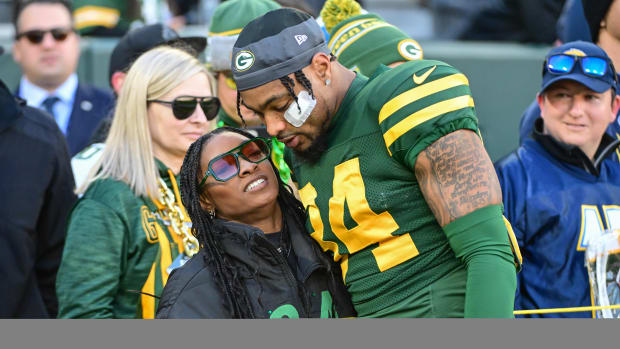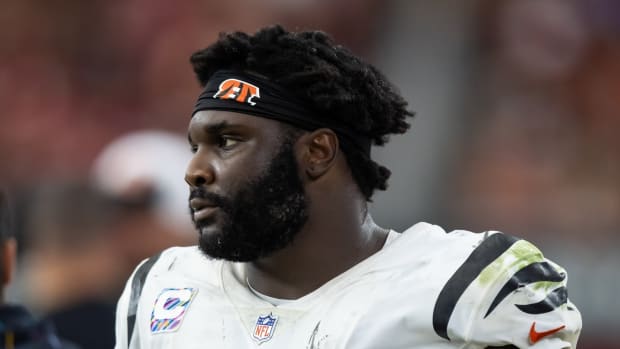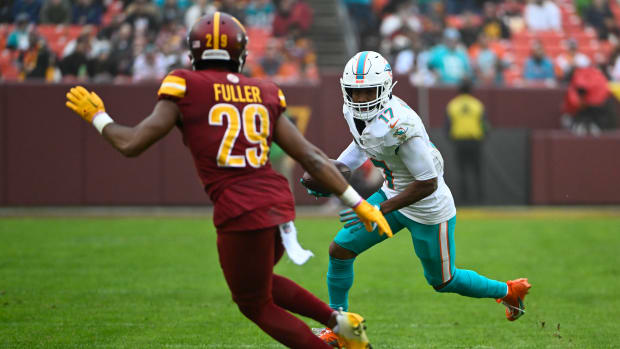GamePlan: What Trends From the 2021 NFL Season Will Continue?
It worked. Boy, did it work.
And while there’s more to what the Rams accomplished this season—a big part was the coaches being clear on what they needed, the front office’s drafting to those needs off a shrunken draft board and the coaches developing what became depth—there’s truth in the spirit of the T-shirt GM Les Snead wore to the championship parade on Wednesday. Maybe it’s not … screw them picks. But the idea sure is not to overvalue those of the first-round variety.
And that will give the NFL plenty to think about coming out of the 2021 season, and even more so when people drill down on the particulars of how the Rams’ roster came to be. All you have to do is take a look at the result of the team’s highest-leverage dice rolls to see it.
• The Rams sent two first-round picks and a fourth-rounder to the Jaguars. The first rounders were both in the 20s: One became K’Lavon Chaisson, the other Travis Etienne. The Jaguars actually wound up trading the fourth-rounder back to the Rams, and it became DB Robert Rochell.
• The Rams sent two first-rounders, a 2021 third-rounder and QB Jared Goff to the Lions for Matthew Stafford. The third-rounder wound up becoming Lions CB Ifeatu Melifonwu. The first of the two first-rounders will be the 32nd pick this April.
• The Rams sent 2022 second- and third-rounders to the Broncos for OLB Von Miller. Those will be the 64th and 96th picks in the draft.
• The Rams sent a 2022 sixth-rounder and ’23 fourth-rounder to the Patriots for Sony Michel.
• The Rams expect to have nine picks in April, despite all this, to keep growing the aforementioned depth. They have their slotted fourth-, fifth- and seventh-rounders; project to get a comp fourth for John Johnson and comp sixths for Samson Ebukam, Troy Hill and Gerald Everett; and they have a spare seventh coming back from the Dolphins for the Aqib Talib trade.
There are, as we discussed in this week’s MAQB, elements of the Rams’ approach that won’t be replicable for other teams. Being in Los Angeles allows the Rams to confidently deal for veterans on expiring deals with the thought they’ll be motivated to stay. Having Sean McVay has meant being able to gamble on guys other teams can’t, feeling strongly that the culture he’s built will make the risk of taking on malcontents melt away.
But as for the valuation of draft picks? There’s definitely something there.
We’ll dive into that in this week’s GamePlan as we look at the trends of 2021.
In talking about the Rams’ construction with rival executives over the last couple of days, one drew a particularly interesting analogy to describe it.
“It’s more analytically driven than people think,” said one NFC exec. “It’s like baseball people say, ‘The minor leaguers are there to give us trade possibilities.’ You’re just doing it with a different pool of players. You’re still focused on using draft choices to build a team, it’s just not part of the TV show. … You’re using them to get players, except those players aren’t walking across the red carpet.”
So go ahead and add up the acquisitions above. The Rams sent away picks that became Chaisson, Etienne, Melifonwu and Rochell; as well as the 32nd, 64th and 96th picks; plus a sixth-rounder in this year’s draft and first- and fourth-rounders in next year’s draft; for Stafford, Ramsey, Miller and Michel. And they did it in a way that enabled them to maintain the volume of picks they have year to year, to build the aforementioned depth.
Again, while not all of that’s going to be replicable for everyone, there is the question of how picks are valued (or devalued) going forward as a result of the Rams’ success.
“I think they probably should be [devalued],” said another NFC exec.
Adding to the intrigue is that this year’s draft class is considered shaky at the top, and is bereft of high-end quarterback prospects. So, if there’s ever a year in which teams should at least be open to the idea of exploring swings on veteran players, this might be the one. And then, in turn, there could be added opportunity for rebuilding teams to peddle veteran players who might not be long for them, in hopes of scoring an overpay from another team.
Which is to say trade discussions should be active during combine week, two weeks from now, and ahead of the new league year on March 17. And the context of those talks could be different than they’ve been in the past, thanks to the newly crowned champs.
Here are a few more trends to take away as we wrap up the season.
More two-high looks on defense. This is an in-the-weeds, schematic thing, but everyone I talked to brought it up. With the Chiefs becoming a model on offense, and a young set of cannon-armed quarterbacks coming of age, a tidal wave of two-high looks flooded NFL game tape this fall. The idea goes back to how Bill Belichick has defended Patrick Mahomes in Patriots-Chiefs games, saying, conceptually: We’re going to make you go 14 plays, rather than four, and we hope you’ll mess it up somewhere along the way.
It’s precisely what Mahomes saw early in the year and a big reason for the quarterback’s struggles in September and October. Eventually, Mahomes adjusted and worked through it—and then, the Bengals adjusted again, dropping defensive linemen as the eighth man in coverage to further frustrate the quarterback (which actually worked).
To me, it’s a great illustration of the cat and mouse game that football presents. NFL teams draft freaky quarterbacks to find their own Mahomes and draft speed to get their own Tyreek Hill. Then, knowing offenses are carrying home run hitters, defenses are trying to make them play small ball.
A premium on faster linebackers. And this actually may have best been brought to life by the team that lost the Super Bowl. Cincinnati’s young ’backers, Germaine Pratt and Logan Wilson, were monsters in the run game on Sunday, holding Cam Akers and the Rams’ running backs to 30 yards on 19 carries. Their success is indicative of where NFL defenses are going.
Simply put, absent being heavier on the edges and playing perfect fundamentally, fast, long linebackers are the best way to combat the outside-zone-centered Shanahan run games. Maybe the best proof of that is that Kyle Shanahan himself has invested in the Seattle scheme that prioritizes these sorts of linebackers, athletic enough to run sideline to sideline and blow up his run calls.
(For what it’s worth, this sort of dynamic should boost the value of a player like Utah’s Devin Lloyd in the draft.)
Fundamental issues on the offensive line. This has been happening for years but really became evident in 2021—offensive line play is the one area where cutbacks in practice time and contact during the season are most being felt.
“I saw a lot of offensive lines unable to play low,” said an AFC exec. “A lot of guys are out there playing high, getting run through, not getting leverage. You’d hope the trend pushes an emphasis to get more of these guys playing with leverage.”
The exec added that, in addition to missing on-field work time due to changing rules, “It’s the emphasis on the passing game. You spend more time on the passing game, and this is what you get—some of that’s the rules, some of that’s just the way the game is going. And then teams are way more focused on scheme than fundamentals. So they’re walking through blitz pickup instead of hammering out the fundamentals.”
The truth is, both offensive lines had their issues in the Super Bowl, and ill-equipped lines have had a serious effect on the playoffs in each of the last two years. The exec said it’s not an issue for everyone (the Titans, Browns and Patriots were raised as exceptions), but “at least half the teams” in the NFL have these problems up front. And if fundamentals keep getting thrown overboard, the problem could compound next year.
Freaky pass-rushers only make that issue more pronounced. The value of great ones continues to rise. And the last two Super Bowls can provide reasoning for it. The Bucs beat the brakes off the Chiefs’ intergalactic offense because Kansas City couldn’t handle Tampa’s rushers, and the difference for the Rams on Sunday against the Bengals was, more or less, Aaron Donald’s ability to get to Joe Burrow before Burrow could get the ball deep to a wide-open Ja’Marr Chase (and, of course, the seven sacks the Rams had separate from that).
These scenarios played out across the NFL this year. T.J. Watt matched Michael Strahan’s single-season sack record in just 15 games. Nick Bosa registered 15.5 sacks, coming off a torn ACL. Micah Parsons had 13 sacks as a rookie, despite the fact that he’s, by trade, an off-ball linebacker who isn’t rushing all the time.
It’s why Aidan Hutchinson and Kayvon Thibodeaux won’t have to wait long to hear their names called on draft night (even if neither guy is a Myles Garrett, Chase Young or Bosa physically), and why there’ll be at least a few more pass rushers taken in the first round. It’s also why third-contract vets like Miller and Chandler Jones have a shot at another big pay day next month.
The idea that pass rushers are valuable obviously isn’t new. But it is becoming more pronounced.
The Niners’ figuring out how to best use Deebo Samuel should have ripple effects. Really, this one’s been a sort of conundrum for NFL coaches going back to Percy Harvin—who was on the front end of the do-everything skill player coming into the NFL. Those guys, 25 years ago, probably would’ve been tailbacks. Economics and football schematics (at every level of the game) have pushed them to receiver. And maximizing them has always been a challenge.
“It’s using your weapons as weapons, how [Shanahan] uses Deebo,” said a third NFC exec. “People have tried it in the past; it really did start with Percy, with Josh [McDaniels] putting [Aaron] Hernandez in the backfield. But there have always been guys like De’Anthony Thomas, where people have trouble figuring out how to use them.”
Samuel’s success helps, to be sure, in illuminating that it can be done, and how it can be done, even if some of his success is due to his being a unique player. So, surely, others are going to try to find their own version of him. ‘The kid coming out of Kentucky,” the exec continued, “I guarantee you someone’s going to draft him relatively high, wanting to use him that way.”
In case you want to keep track, that kid’s name is Wan’Dale Robinson.
Depth is, and will be, more important than ever. We saw it show up on Sunday, with the Rams’ needing Cooper Kupp to be Superman after all their receiver injuries, and with the Bengals’ missing their big-ticket free-agent acquisition of a right tackle, Riley Reiff, in a very big way. And really, it was all over the league this year—with expanded practice squads becoming a big part of how teams managed the expanded regular season and playoffs.
“The more liberal roster rules, in terms of using depth, you’re seeing it make a difference late in the season,” said our AFC exec. “The rules facilitate that. … I’m not sure, physically, the depth is better. It’s just more necessary, and everyone recognizes it, so you’re coaching to it more, you’re getting ready for it more. So people aren’t tucked away. Everyone understands that if you’re in the building, you could wind up with a uniform.
“It’s good, too, because it’s kept more veterans’ careers alive, guy who’ve played, who bring more experience. And that makes the game cleaner when you’re challenged roster-wise.”
It’s a safe bet that every coach and GM out there wants the COVID-19-fueled rule changes that facilitated the expanded practice squads to become permanent.
Quarterbacks keep mattering more. But you knew that. And we’ve been over it.
The Rams pulled the plug on Goff for Stafford. The Niners started the process of moving off Jimmy Garoppolo to go to Trey Lance.
“It’s the power of the quarterback position and having a guy solidified there,” said our third NFC exec. “With that O-line Joe Burrow had, any lesser quarterback isn’t making it. But he has the it factor, that Brady quality about him, where he lifts everyone around him, and can compensate for the guys up front. He got sacked seven times, but still gets the ball out accurately and damn near won the game.”
And on the other side, there was Stafford himself, who led the Rams down the field when it mattered most, despite the absence of Robert Woods, Tyler Higbee, Odell Beckham Jr. and any semblance of a run game.
“All of us have been on sped-up quarterback clocks anyway,” said our second NFC exec. “That’s been a couple years now, and it’s only happening faster. Really, it started with [Josh] Rosen being given up on after one year, that spoke to it, too. Everyone sees these things in windows now, and if you think you’re in one, you have to act aggressively.”
Of course, no one epitomizes that idea more than the new champs.
Now that we’ve given you that shot, here’s the chaser: The Rams’ way worked for them, but maybe the overarching lesson of this year’s Super Bowl is, simply, to find your own way, while borrowing from others. The truth is, most teams that get to that level have blueprints that are all their own.
“The two teams that made it to the Super Bowl show you how many ways there are to skin a cat,” said the third NFC exec. “The Rams built through free agency and trades. The Bengals built primarily through the draft. It all comes down to understanding your team and what it needs, and having the fortitude to attack those needs.”
Really, that’s what the Rams did, in their very own way. The Bengals, too.
And therein may lie the most important things for other teams to take away from all this.
ONE BIG QUESTION
What becomes of the GamePlan now that the season is over?
Well … this column was born with a game-weekend preview concept, and when we relaunched it after it went on hiatus over the summer, it came back with that in mind. We’ll be reworking it again for the offseason—obviously, the sections set up to look forward to matchups and betting lines won’t fly when there aren’t any games to be played.
Stay tuned for more info, and hopefully we’ll have more answers for you a couple weeks from now from the combine.
More NFL Coverage:
• MMQB Mock Draft 1.0: Kenny Pickett Is QB1
• How the Rams Got Away, Found One Another, Then Found a Way
• Matthew Stafford Rewrote His Story With a Super Bowl Season
• How Aaron Donald Became Aaron Donald





































